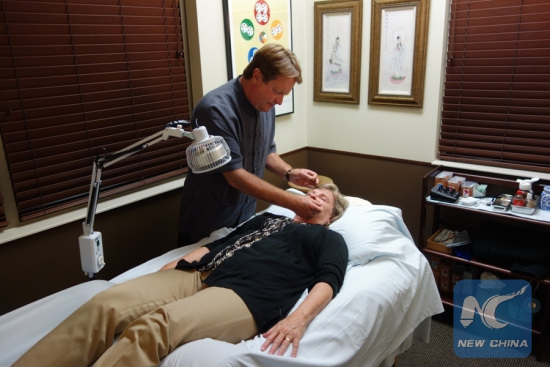
Acupuncturist Paul Murray practices at Whole Health Center in Denver, Colorado, the United States, on Sept. 26, 2017. (Xinhua)
Although traditional Chinese medicine as a whole is struggling in the United States, acupuncture itself is in a much better situation.
The ancient Chinese practice involving the insertion of fine needles into the skin was generally thought to be brought to America in the early 1970s, thanks to then-President Richard Nixon's ice-breaking visit to China.
About 45 years later, over 46 U.S. states have legalized acupuncture, and the number of licensed acupuncturists in the country has grown to around 45,000.
BIGGER ROLE
Now, local acupuncturists expressed hope that the ancient art of healing could play a bigger role in solving the ongoing U.S. opioid epidemic, which claims 91 American lives every single day.
"Acupuncture is an effective, safe, and cost-effective treatment for numerous types of acute and chronic pain," wrote a white paper released this week by several organizations that promote the practice in the United States.
"Acupuncture should be recommended as a first line treatment for pain before opiates are prescribed, and may reduce opioid use."
The white paper came about a week after the U.S. National Association of Attorneys General (NAAG) sent a letter to America's Health Insurance Plans (AHIP), asking its insurance company members to review their payment and coverage policies in order to promote alternatives to opioids, such as acupuncture.
Cathryn Donaldson, director of communications and public affairs for the AHIP, a trade association representing 1,300 health insurers, told Xinhua that they have responded to the NAAG letter, which was signed by 37 state and territorial attorneys general.
"Plans are exploring and improving access to non-pharmacologic pain treatments that have been proven effective in reducing pain," Donaldson said in an email.
"Depending on the individual patient, therapies like acupuncture, mind-body interventions (yoga), psychological interventions (cognitive therapy), and exercise can be an effective first line of treatment for many before moving on to pharmaceuticals when necessary," she said.
BIG DEAL
Although millions of Americans use acupuncture each year, the practice was considered primarily to be a complementary health approach.
As a result, many American acupuncturists were excited by the NAAG letter, which was virally spread and heatedly discussed in the social media. One of them, Fan Ying, whose clinic is based in the state of Virginia, called it "a big deal" for the industry.
"The spring of acupuncture might have come," said Fan, one of the authors of the white paper.
"The U.S. opioid crisis will allow non-pharmacologic therapies, including acupuncture, chiropractic care and medical massage, to have a place in the U.S. healthcare system," he said, but cautioned that "we can't say there will be no spring chill in the future."
Li Yongming, a licensed acupuncturist in the state of New Jersey, called the U.S. fight against opioid abuse and addiction "a new opium war."


















































